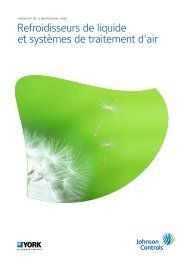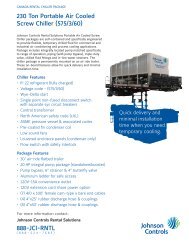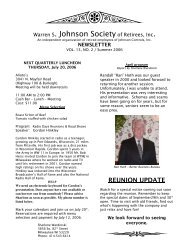Rxf - Johnson Controls Inc.
Rxf - Johnson Controls Inc.
Rxf - Johnson Controls Inc.
Create successful ePaper yourself
Turn your PDF publications into a flip-book with our unique Google optimized e-Paper software.
an allowance in the readings must be made by subtracting<br />
approximately 0.02 VDC per 1000 feet of elevation above<br />
sea level. Barometric pressure can generally be ignored but<br />
in extreme cases may be compensated for by adding/subtracting<br />
0.002 VDC for each 0.1 inch of barometric pressure<br />
(adjusted to sea level) above/below 0 PSIG. Therefore, if<br />
(PE-4) is measured at 5000 feet elevation under relatively<br />
normal weather conditions, the output voltage should differ<br />
by 0.10 VDC to read between 1.38 VDC and 1.62 VDC.<br />
5. Subtract 1 from the voltage.<br />
6. Multiply by 25.<br />
7. This result is the absolute suction pressure (PSIA). Subtract<br />
14.7 to obtain PSIG which the Operating display will indicate.<br />
8. Isolate the oil pressure transducers (PE-1 & PE-2) from<br />
the package and depressurize. NOTE: Recover or transfer<br />
all refrigerant vapor, in accordance with local ordinances,<br />
before opening to atmosphere.<br />
9. Measure the voltage of (PE-1 & PE-2) on connector (P5A)<br />
(terminals 5 and 6) on the analog board.<br />
10. The voltage reading should be between 1.1 VDC and 1.29<br />
VDC at standard atmospheric pressure. (PE-1 & PE-2) and<br />
(PE-3) have a span of 500 PSI as compared to (PE-4) with a<br />
span of 200 PSI. Therefore, atmospheric pressure changes<br />
have a lesser effect which is 0.0067 VDC per 1000 feet of<br />
eleva tion and 0.00067 VDC per 0.1 inch Hg baro metric deviation.<br />
11. Subtract 1.2 from the voltage.<br />
12. Multiply by 75, the result will be PSIG.<br />
13. Since the discharge pressure (PE-3) cannot be closed<br />
off from its sensing point (code require ments), remove all<br />
transducers from atmosphere and open them to their sensing<br />
points so all transducers can equalize to separator pressure.<br />
14. Measure the voltage of (PE-3) on connector (P5B) (terminals<br />
5 and 6) on the analog board.<br />
15. Test complete.<br />
PRESSURE TRANSDUCERS REPLACEMENT<br />
1. Shut off control power.<br />
2. Close the applicable transducer isolation valve. NOTE: To<br />
change the discharge pressure transducer ( PE-3), it will be<br />
necessary to depressurize the entire compressor package.<br />
Follow "General Instructions For Replacing Compressor Unit<br />
Components" section before going to step 3.<br />
3. Remove DIN connector screw, then remove DIN connector<br />
from the transducer.<br />
TRANSDUCER CONNECTION<br />
Suction Pressure PE-4<br />
Discharge Pressure PE-3<br />
Oil Pressure PE-1 & PE-2<br />
4. Unscrew the transducer using a wrench on the metal hex at<br />
the base of the transducer. DO NOT ATTEMPT TO LOOSEN<br />
OR TIGHTEN TRANSDUCERS BY THEIR TOP CASING.<br />
5. Install new transducer, reconnect DIN connector, and<br />
retighten DIN connector screw.<br />
RXF ROTARY SCREW COMPRESSOR UNITS<br />
MAINTENANCE<br />
070.410-IOM (JUL 11)<br />
Page 33<br />
6. Recalibrate. NOTE: If replacing older hard-wired transducer,<br />
cut cable at back of old transducer and rewire to<br />
the Danfoss unit.<br />
7. Reopen the transducer isolation valve or compressor package<br />
isolation valves.<br />
8. Turn on control power.<br />
SLIDE VALVE TRANSMITTER<br />
REPLACEMENT - SLIDE STOP<br />
The Slide Valve Transmitter (Figure 34) is located on the<br />
right side of the compressor (facing shaft) at the inlet end.<br />
The linear transmitter with hermetic enclosure is based on<br />
the inductive measuring principle. It features removable<br />
electronics (from the sensor well) eliminating the need to<br />
evacuate the compressor for replacement. This type of<br />
transmitter is dedicated to volume ratio control and has no<br />
user adjustments.<br />
1. Shut off control power.<br />
2. Remove DIN connector plug from transmitter.<br />
3. Loosen set screws.<br />
4. Remove transmitter unit.<br />
5. Install new transmitter unit.<br />
6. Tighten set screws.<br />
7. Apply DIN connector plug to transmitter.<br />
8. Turn on control power.<br />
NOTE: For calibration of the Slide Valve unit, refer to the<br />
Analog Calibration instructions in publication 090-020 O.<br />
Figure 34 - Slide Valve Transmitter<br />
TEMPERATURE SENSOR REPLACEMENT<br />
1. Shut off control power.<br />
This device is static sensitive. Please<br />
follow proper ESD procedures when<br />
handling.<br />
2. Remove DIN connector plug from transmitter. See Figure 35.<br />
3. Unscrew knurled ring and remove transmitter unit.<br />
4. Apply thermal compound to new sensor assembly, insert<br />
into thermal well, and tighten knurled ring.<br />
5. Apply DIN connector plug to transmitter.<br />
6. Turn on control power.










![[PDF] Intelligent Fire Annunciator IFA-1000 - Johnson Controls Inc.](https://img.yumpu.com/7424420/1/190x245/pdf-intelligent-fire-annunciator-ifa-1000-johnson-controls-inc.jpg?quality=85)





